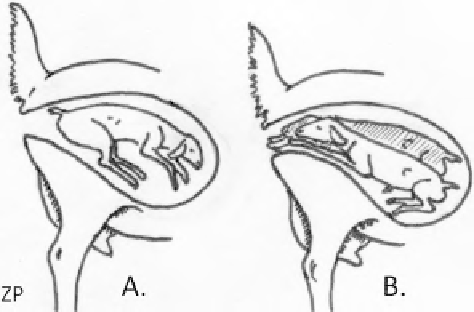Agriculture Reference
In-Depth Information
quent urination, and mucous discharge from the vulva. The
ligaments in the pelvic area will relax, and the udder secre-
tion will change from clear honey-like to yellowish and
thick (colostrum). There are three stages of parturition.
Stage 1 consists of uterine contractions and cervical dila-
tion, and it usually lasts 2-6 hours. At the end of this stage,
the fi rst water bag or chorioallantois will break, and the
doe will go into the second stage of parturition. During the
second stage, the doe will have abdominal contractions
along with the uterine contractions, and it will last from
30 minutes to 2 hours. If the doe is straining for more than
an hour after the water bag has broken without any prog-
ress, or more than 30 minutes between kids, assistance is
needed. Stage 3 consists of expulsion of the placenta or
afterbirth, and it usually lasts 5-8 hours.
Problems during parturition may be due to an oversized
kid, more than one kid entering the birth canal at a time,
or postural defects (leg or head turned back, breech, that
is, coming backward with both hind legs bent forward).
When assisting birth, it is important to clean the area
around the vulva with a disinfectant and warm water and
wear gloves to assist. There are certain diseases that can
be transmitted to humans during this time; therefore, preg-
nant women should not assist with the kidding process.
Lubricate the hand prior to entering the vagina. Feel and
identify the parts of the kid. Try to ensure that all body
parts felt belong to the same kid and not to a twin kid.
Make sure the kid is in a normal presentation, position, and
posture. Normal presentation is anterior longitudinal,
dorso-sacral, and both front legs extended with the head
between the legs. The fetus may have to be pushed forward
toward the doe's head until the front legs and head are
repositioned. Once the limbs and head are in a proper posi-
tion, the kid should be gently pulled with plenty of
lubrication.
Clear the mouth and nasal passages of the kid and stimu-
late respiration by irritating the nasal passages with straw.
Never apply traction on any other presentation other than
a normal presentation of two front legs and a head or a
presentation of two hind legs and a tail. Pulling on an
abnormal presentation, position, and posture will make it
diffi cult to correct (Figure 12.13A).
If the anticipated kidding problems appear severe, a
veterinarian must be called immediately (Dawson, 2007b;
Swize, 2007 ).
Figure 12.13
A: Breech presentation. B: Twins.
Drawn by Zeke Proctor.
isms and also to promote rapid drying and the eventual
breaking away of the cord from the navel. Another critical
practice is the feeding of colostrum as soon after birth as
possible. The colostrum, or fi rst milk, contains antibodies,
which the doe does not pass on to the fetus in the womb.
Consumption of colostrum must occur as early as possible,
ideally within 2-4 hours of birth. At 24 hours after birth,
there is a rapid reduction in the absorption of colostral
antibodies through the mucosa of the intestine. If a newborn
kid does not or cannot nurse, the colostrum should be
bottle-fed or the kid should be tube fed to ensure adequate
consumption.
Kids should receive colostrum equal to 10% of their
body weight during the fi rst 24 hours of life. For example,
a 6-pound or 2.8-kg kid (96 ounces) should receive
approximately 10 ounces (300 mL) of colostrum, or 1
ounce (30 mL) of colostrum per pound (about 0.5 kg body
weight) within 24 hours of birth. This should be divided
into at least three feedings. If fresh or frozen goat colos-
trum is not available, sheep or cow colostrum or colostrum
substitutes could be used. Caprine Arthritis Encephalitis
(CAE) virus can spread from the doe to her kids through
her colostrum and milk. One of the measures advocated to
control CAE virus in an infected herd is to remove the kids
as soon as they are born, raise the kids on a bottle, and
feed them CAE-free colostrum, heat-treated colostrum, or
colostrum substitutes and milk replacer until they are
weaned from milk.
Under certain conditions newborn kids may benefi t from
injections of vitamins A and D approximately 3-4 days
after birth if they are raised away from sunlight. An iron
dextran injection may be given if kids are raised in a barn
Kid Management at Birth
At birth, two management practices are critical to the
future health and survival of the newborn kid. Dipping the
cord in iodine is very important to prevent entry of organ-







